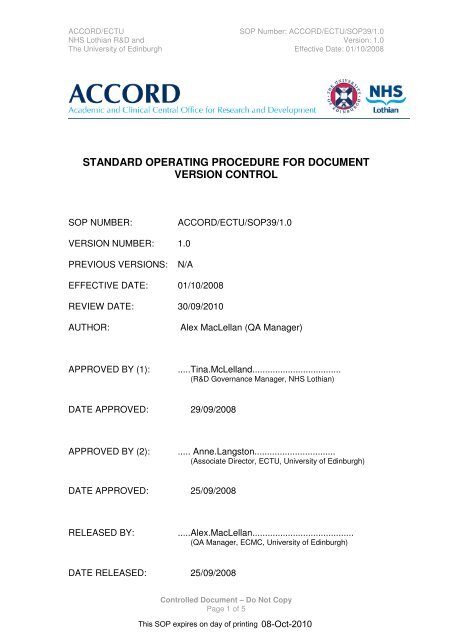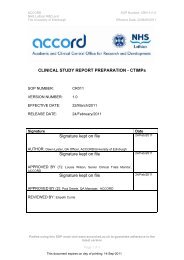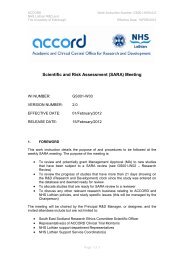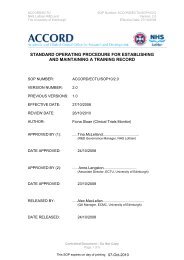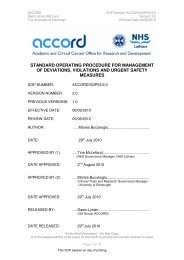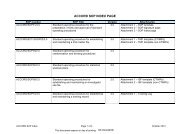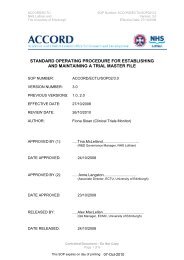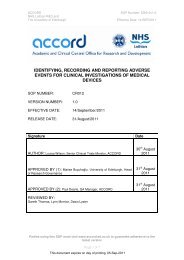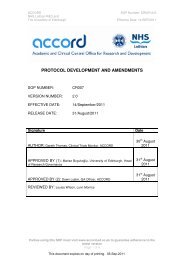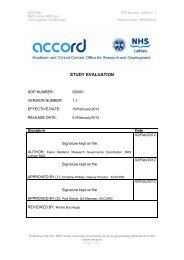standard operating procedure for document version control - Accord
standard operating procedure for document version control - Accord
standard operating procedure for document version control - Accord
Create successful ePaper yourself
Turn your PDF publications into a flip-book with our unique Google optimized e-Paper software.
ACCORD/ECTU<br />
SOP Number: ACCORD/ECTU/SOP39/1.0<br />
NHS Lothian R&D and Version: 1.0<br />
The University of Edinburgh Effective Date: 01/10/2008<br />
STANDARD OPERATING PROCEDURE FOR DOCUMENT<br />
VERSION CONTROL<br />
SOP NUMBER:<br />
ACCORD/ECTU/SOP39/1.0<br />
VERSION NUMBER: 1.0<br />
PREVIOUS VERSIONS: N/A<br />
EFFECTIVE DATE: 01/10/2008<br />
REVIEW DATE: 30/09/2010<br />
AUTHOR:<br />
Alex MacLellan (QA Manager)<br />
APPROVED BY (1):<br />
.....Tina.McLelland...................................<br />
(R&D Governance Manager, NHS Lothian)<br />
DATE APPROVED: 29/09/2008<br />
APPROVED BY (2):<br />
..... Anne.Langston................................<br />
(Associate Director, ECTU, University of Edinburgh)<br />
DATE APPROVED: 25/09/2008<br />
RELEASED BY:<br />
.....Alex.MacLellan........................................<br />
(QA Manager, ECMC, University of Edinburgh)<br />
DATE RELEASED: 25/09/2008<br />
Controlled Document – Do Not Copy<br />
Page 1 of 5
ACCORD/ECTU<br />
SOP Number: ACCORD/ECTU/SOP39/1.0<br />
NHS Lothian R&D and Version: 1.0<br />
The University of Edinburgh Effective Date: 01/10/2008<br />
DOCUMENT HISTORY<br />
Version Edited by (job title): Effective Details of editions made:<br />
Number:<br />
Date:<br />
1.0 01/10/2008 Original<br />
1. PURPOSE<br />
Version <strong>control</strong> is the management of multiple revisions to the same <strong>document</strong>.<br />
Version <strong>control</strong> enables us to tell one <strong>version</strong> of a <strong>document</strong> from another.<br />
Version <strong>control</strong> is important <strong>for</strong> <strong>document</strong>s that undergo a lot of revision and<br />
redrafting and is particularly important <strong>for</strong> electronic <strong>document</strong>s because they can<br />
easily be changed by a number of different users, and those changes may not be<br />
immediately apparent. Knowing which <strong>version</strong> of a <strong>document</strong> you are looking at is<br />
important if you are trying to find out which <strong>version</strong> of a <strong>document</strong> is currently in<br />
<strong>for</strong>ce, or which <strong>version</strong> was in use at a particular time. Version <strong>control</strong> is also<br />
important if one is working on a collaborative <strong>document</strong> with a number of contributors<br />
and/or frequent revisions.<br />
2. APPLICABILITY<br />
This SOP applies to all staff who create and edit <strong>document</strong>s with multiple <strong>version</strong>s.<br />
3. POLICY<br />
Any staff member can per<strong>for</strong>m the activities described in this <strong>procedure</strong>.<br />
4. PROCEDURE<br />
4.1 Version Numbers<br />
4.1.1 Use a unique <strong>version</strong> number to distinguish one <strong>version</strong> from another.<br />
Use this <strong>procedure</strong> <strong>for</strong> all <strong>document</strong>s where more than one <strong>version</strong> exists, or<br />
is likely to exist in the future.<br />
4.1.2 The numbering system which should be used, uses consecutive whole<br />
numbers, i.e. <strong>version</strong> 1 <strong>for</strong> the first, <strong>version</strong> 2 <strong>for</strong> the second and so on. A<br />
Controlled Document – Do Not Copy<br />
Page 2 of 5
ACCORD/ECTU<br />
SOP Number: ACCORD/ECTU/SOP39/1.0<br />
NHS Lothian R&D and Version: 1.0<br />
The University of Edinburgh Effective Date: 01/10/2008<br />
minor or major change will result in the use of the next consecutive whole<br />
number.<br />
4.1.3 There can be any number of draft copies of each <strong>version</strong>. If a new<br />
<strong>document</strong> has three draft copies they should be labelled ‘<strong>version</strong> 1 draft 1’,<br />
<strong>version</strong> 1 draft 2’ & ‘<strong>version</strong> 1 draft 3’ not ‘<strong>version</strong> 1’, ‘<strong>version</strong> 2’ and ‘<strong>version</strong><br />
3’.<br />
4.1.4 Put the <strong>version</strong> number on the <strong>document</strong> itself. The placement of the<br />
<strong>version</strong> number will depend on the style of the <strong>document</strong>, but the most<br />
common places <strong>for</strong> <strong>version</strong> numbers are the <strong>document</strong> cover, or in either the<br />
header or footer text of each page.<br />
4.2 Naming Conventions<br />
4.2.1 For SOPs, include the <strong>version</strong> number at the end of the <strong>document</strong><br />
number, as described in section 5.3 of the SOP ECMC/ADM/001.<br />
4.2.2 For all other <strong>document</strong>s include the <strong>version</strong> number at the end of the<br />
<strong>document</strong>’s file name e.g. ‘SOP Review Checklist <strong>version</strong> 1’.<br />
4.2.3 Always add the date, to the header and/or footer, when any changes<br />
were made to the <strong>document</strong>.<br />
4.2.4 The words ‘Draft’ or ‘Final’ can be added to the end of the file name to<br />
indicate the status of the <strong>version</strong>.<br />
4.2.5 Use this <strong>procedure</strong> <strong>for</strong> all <strong>document</strong>s where more than one <strong>version</strong><br />
exists, or is likely to exist in the future.<br />
4.3 Read-only Option<br />
4.3.1 To reduce the likelihood of one <strong>version</strong> being overwritten with another<br />
use the read-only tag. Applying a read-only tag will prompt<br />
users to save the <strong>document</strong> with a new <strong>version</strong> number if they make any<br />
changes to the original <strong>document</strong>.<br />
4.3.2 Use this <strong>procedure</strong> <strong>for</strong> finalised <strong>document</strong>s where loss of the original<br />
would be a problem e.g. participant clinical study <strong>document</strong>ation.<br />
4.3.3 To add a read-only tag to your <strong>document</strong>:<br />
• On your computer screen, navigate to your <strong>document</strong>.<br />
• Right click on the <strong>document</strong> name and select ‘Properties’.<br />
• On the ‘General’ tab check the ‘Read-only’ box.<br />
• Select ‘Apply’ and then ‘OK’.<br />
4.4 PDF Option<br />
Controlled Document – Do Not Copy<br />
Page 3 of 5
ACCORD/ECTU<br />
SOP Number: ACCORD/ECTU/SOP39/1.0<br />
NHS Lothian R&D and Version: 1.0<br />
The University of Edinburgh Effective Date: 01/10/2008<br />
If one is not keeping an editable <strong>version</strong>, a PDF (Portable Document Format)<br />
copy of the <strong>document</strong> can be created. Depending to which computer system<br />
one is linked, the creation of these files will involve different methods.<br />
Conferring with one’s local IT Administrator is suggested if creation of this<br />
type of file is required.<br />
4.5 Document Tracking<br />
5.5.1 For regulatory requirements, it is necessary to keep track of <strong>document</strong><br />
changes to show when and which changes were made. This can be done by<br />
a <strong>version</strong> <strong>control</strong>/history table or a saved ‘track changes’ file.<br />
4.5.2 The table should be updated each time a change is made to the<br />
<strong>document</strong>, with the answers to the following questions:<br />
• What is the new <strong>version</strong> number?<br />
• What was the change?<br />
• Who made the change?<br />
• When was the change made?<br />
4.5.3 The table can either be included at the start of the <strong>document</strong>, e.g. in<br />
SOPs, or it can be created as a separate <strong>document</strong> and filed in the same<br />
folder as the <strong>document</strong> concerned.<br />
4.5.4 A ‘track changes’ file can be created <strong>for</strong> every new <strong>version</strong> by using the<br />
‘Track Changes’ option found on the Microsoft ‘Tools’ menu bar. This shows<br />
all changes that have been made to the previous <strong>version</strong>. This <strong>document</strong><br />
should be saved and filed in the same folder as the <strong>document</strong> concerned.<br />
4.5.5 Remember to remove track change in<strong>for</strong>mation from the final <strong>version</strong> of<br />
the <strong>document</strong>.<br />
5. ATTACHMENTS<br />
N/A.<br />
6. RELEVANT DOCUMENTS<br />
N/A.<br />
7. DEFINITIONS<br />
N/A.<br />
8. REFERENCES<br />
Controlled Document – Do Not Copy<br />
Page 4 of 5
ACCORD/ECTU<br />
SOP Number: ACCORD/ECTU/SOP39/1.0<br />
NHS Lothian R&D and Version: 1.0<br />
The University of Edinburgh Effective Date: 01/10/2008<br />
The Medicines <strong>for</strong> Human Use (Clinical Trials) Regulations 2004, (SI 2004 No. 1031).<br />
The Medicines <strong>for</strong> Human Use (Clinical Trials) Amendment Regulations 2006, (SI<br />
2006 No. 1928).<br />
Good Clinical Laboratory Practice (GCLP), BARQA 2003.<br />
Declaration of Helsinki, Clarification of 5 th Revision, 2004.<br />
Controlled Document – Do Not Copy<br />
Page 5 of 5


